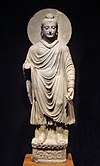Omori Sogen

Multi tool use
Ōmori Sōgen Rōshi | |
|---|---|
 | |
| Title | Rōshi |
| Personal | |
| Born | 1904 Japan |
| Died | 1994 |
| Religion | Buddhism |
| School | Rinzai |
| Senior posting | |
| Based in | Tenryū-ji |
| Predecessor | Seki Bokuo |
Part of a series on |
| Zen Buddhism |
|---|
 |
Main articles
|
Persons Chán in China
Zen in Japan
Seon in Korea
Zen in the USA
Category: Zen Buddhists |
Doctrines
|
Traditions
|
Awakening
|
Teachings
|
Practice
|
Schools
|
Related schools
|
| Part of a series on |
| Western Buddhism |
|---|
 |
Main articles
|
Tibetan dissemination
|
Theravada dissemination
|
Zen dissemination
|
Amidist dissemination
|
Exchange
|
General Buddhism
|
Ōmori Sōgen (大森 曹玄, 1904–1994) was a Japanese Rinzai Rōshi, a successor in the Tenryū-ji line of Rinzai Zen, and former president of Hanazono University, the Rinzai university in Kyoto, Japan. He became a priest in 1945.
Contents
1 Biography
2 Notable students
3 Bibliography
4 References
5 Sources
6 Further reading
7 External links
Biography
Ōmori Sōgen was a teacher of Kashima Shinden Jikishinkage-ryū swordsmanship,[1] and a calligrapher in the Taishi school of Yamaoka Tesshū. He became well known for his unique approach to Zen practice integrating insights from his martial and fine arts training with traditional Zen methods; this approach has been described as a unity of Zen, Ken ("sword", referring to martial arts or physical culture), and Sho ("brush", referring to calligraphy or fine arts).
Ōmori founded Seitaiji monastery in Japan and Daihonzan Chozen-ji in Honolulu, Hawaii, the first Rinzai headquarters temple established outside Japan according to Rinzai canon law.
Dharma successors and descendents of Omori Roshi are active in both Japan and the West. In the United States, along with Chozen-ji, Daiyuzenji has been established in Chicago, and Korinji near Madison, Wisconsin. In Germany and Austria, there are active groups connected to Sasaki Gensō Rōshi and Hozumi Genshō Rōshi.
Ōmori is the author of more than 20 books in the Japanese language.
Ōmori was also well known for his right wing ultra-nationalist[2] political activism and influence in government circles prior to the outbreak of the Second World War.
Notable students
- Sasaki Gensō Rōshi
- Kadowaki Kakichi Roshi
Author "Zen and the Bible"
Bibliography
Sogen, Omori; Trevor Leggett; Dōgen Hosokawa; Roy Kenichi Yoshimoto (2002). An Introduction to Zen Training: A Translation of Sanzen Nyumon. Tuttle Publishing. ISBN 0-8048-3247-1..mw-parser-output cite.citation{font-style:inherit}.mw-parser-output .citation q{quotes:"""""""'""'"}.mw-parser-output .citation .cs1-lock-free a{background:url("//upload.wikimedia.org/wikipedia/commons/thumb/6/65/Lock-green.svg/9px-Lock-green.svg.png")no-repeat;background-position:right .1em center}.mw-parser-output .citation .cs1-lock-limited a,.mw-parser-output .citation .cs1-lock-registration a{background:url("//upload.wikimedia.org/wikipedia/commons/thumb/d/d6/Lock-gray-alt-2.svg/9px-Lock-gray-alt-2.svg.png")no-repeat;background-position:right .1em center}.mw-parser-output .citation .cs1-lock-subscription a{background:url("//upload.wikimedia.org/wikipedia/commons/thumb/a/aa/Lock-red-alt-2.svg/9px-Lock-red-alt-2.svg.png")no-repeat;background-position:right .1em center}.mw-parser-output .cs1-subscription,.mw-parser-output .cs1-registration{color:#555}.mw-parser-output .cs1-subscription span,.mw-parser-output .cs1-registration span{border-bottom:1px dotted;cursor:help}.mw-parser-output .cs1-ws-icon a{background:url("//upload.wikimedia.org/wikipedia/commons/thumb/4/4c/Wikisource-logo.svg/12px-Wikisource-logo.svg.png")no-repeat;background-position:right .1em center}.mw-parser-output code.cs1-code{color:inherit;background:inherit;border:inherit;padding:inherit}.mw-parser-output .cs1-hidden-error{display:none;font-size:100%}.mw-parser-output .cs1-visible-error{font-size:100%}.mw-parser-output .cs1-maint{display:none;color:#33aa33;margin-left:0.3em}.mw-parser-output .cs1-subscription,.mw-parser-output .cs1-registration,.mw-parser-output .cs1-format{font-size:95%}.mw-parser-output .cs1-kern-left,.mw-parser-output .cs1-kern-wl-left{padding-left:0.2em}.mw-parser-output .cs1-kern-right,.mw-parser-output .cs1-kern-wl-right{padding-right:0.2em}
Terayama, Katsujō; John Stevens; Omori Sogen (1983). Zen and the Art of Calligraphy: The Essence of Sho. Routledge & Kegan Paul. ISBN 0-7100-9284-9.
References
^ (in Japanese) Jiki Shinkage-ryū Kenjutsu with Ōmori Sōgen. Archived 2011-07-08 at the Wayback Machine Japan, Nihon Kobudo series, filmed during the 1970s by the Japanese Ministry of Education in a series on many of the traditional koryū. DVD, 2005.
^ Zen war stories, Daizen Victoria, p85
Sources
Morisawa, Jackson S. (1988). The Secret of the Target. Routledge. ISBN 0-415-00194-3.
Further reading
Hosokawa, Dōgen (1997). Omori Sogen: The Art of a Zen Master. Kegan Paul International : Distributed by Columbia University Press. ISBN 0-7103-0588-5.
External links
- Chozen-ji
- Daiyuzenji
- Korinji
- Ryu-un Zendo
- Chart showing the Rinzai lineage of Omori Sogen Roshi
This Zen-related article is a stub. You can help Wikipedia by expanding it. |
g 3j5O7b0uL,D9Y 6hfzCU2XxqTJAp3K3hVSdCLPoAY